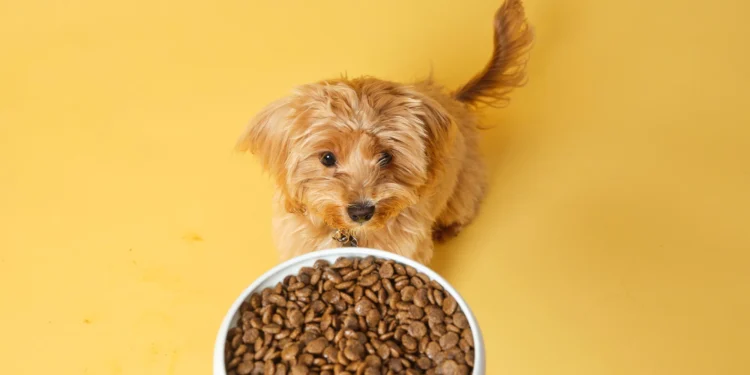The Rise of Grain-Free Dog Food: A Comprehensive Guide

owners’ desire to provide their furry companions with high-quality, healthy, and natural diets, has spurred a variety of products labeled as grain-free. But what exactly is grain-free dog food? Is it really a better option for dogs, or is it simply a marketing gimmick? In this article, we’ll dive deep into the world of grain-free dog food, examining its benefits, potential risks, ingredients, and how to determine whether it’s right for your dog.
What Is Grain-Free Dog Food?
Grain-free dog food, as the name suggests, is dog food that is made without grains such as wheat, corn, rice, barley, oats, and soy. Traditional dog foods often use these grains as carbohydrate sources, but in grain-free formulas, these are replaced with alternative ingredients like potatoes, peas, lentils, and chickpeas to provide the necessary energy and fiber.
The rationale behind the grain-free movement is based on the belief that dogs, as descendants of wolves, are carnivores and therefore have no need for grains in their diets. This idea aligns with the broader trend of feeding dogs diets that resemble what their ancestors would have eaten in the wild.
Common Ingredients in Grain-Free Dog Food
To replace grains, grain-free dog foods often use a variety of alternative carbohydrate sources. Here are some of the most common ingredients found in grain-free formulas:
- Sweet Potatoes: A rich source of dietary fiber and vitamins, sweet potatoes are often used in grain-free dog foods as a healthy alternative to grains. They provide essential carbohydrates and are easy for dogs to digest.
- Peas: Peas are a popular choice in grain-free dog foods. They offer a good source of plant-based protein, fiber, and various vitamins and minerals.
- Lentils: Like peas, lentils are rich in protein and fiber. They also contain essential nutrients such as iron, potassium, and folate.
- Chickpeas: Chickpeas provide both carbohydrates and protein. They are high in fiber and help support digestive health.
- Potatoes: Potatoes, especially sweet potatoes, are commonly used in grain-free dog foods as a source of digestible carbohydrates and fiber.
- Tapioca: This is a starchy substance extracted from cassava root, and it’s often used in grain-free dog foods as a filler or binding agent.
These ingredients serve to provide energy and essential nutrients, but the question of whether they are superior to grains for dogs remains a topic of debate among veterinarians and pet nutritionists.
The Alleged Benefits of Grain-Free Dog Food
Proponents of grain-free diets for dogs point to several potential benefits, claiming that these diets are more aligned with the natural diet of a canine, are less likely to cause allergies, and offer better digestibility. Below are some of the most commonly cited benefits:
1. Reduced Allergies and Sensitivities
One of the primary reasons many pet owners switch to grain-free dog food is due to concerns over food allergies. While true grain allergies in dogs are relatively rare, some dogs may have sensitivities to certain grains, especially corn and wheat. Symptoms of food allergies in dogs can include:
- Itchy skin
- Digestive issues (such as diarrhea or vomiting)
- Chronic ear infections
- Excessive licking of paws or other body parts
For dogs with grain sensitivities, eliminating grains from their diet may help alleviate these symptoms. However, it’s important to note that most food allergies in dogs are triggered by proteins (such as beef, chicken, or dairy) rather than grains.
2. Improved Coat and Skin Health
Some advocates of grain-free dog food suggest that removing grains can improve a dog’s coat and skin condition. This claim is based on the idea that grains can cause inflammation or allergic reactions in certain dogs, which in turn can lead to dry, itchy skin or a dull coat. However, this is not universally true for all dogs, and the condition of a dog’s skin and coat is typically more related to the overall quality of their diet rather than the presence or absence of grains.
3. Easier Digestion
Many pet owners who feed their dogs grain-free diets report improved digestion. This is largely due to the high fiber content in grain-free ingredients such as peas, lentils, and sweet potatoes. Dogs with sensitive stomachs or gastrointestinal issues may benefit from a grain-free diet if it helps improve their stool quality and reduces symptoms like gas, bloating, or diarrhea.
4. Weight Management
Grain-free dog foods are often marketed as being helpful for weight management. Since grains like corn and rice can be high in calories and carbohydrates, switching to grain-free formulas that rely on complex carbohydrates (such as sweet potatoes or legumes) may support healthy weight maintenance in some dogs. However, it’s crucial to look at the overall calorie content of the dog food and ensure that portion sizes are appropriate for your dog’s age, size, and activity level.
Potential Risks of Grain-Free Dog Food
While there are potential benefits to feeding your dog a grain-free diet, it’s essential to consider the potential downsides and risks. Over the past few years, grain-free dog food has come under scrutiny due to concerns about its link to certain health issues.
1. Dilated Cardiomyopathy (DCM)
One of the most significant concerns associated with grain-free dog food is its potential link to dilated cardiomyopathy (DCM), a serious heart condition. In 2018, the U.S. Food and Drug Administration (FDA) began investigating reports of DCM in dogs that were being fed grain-free diets. The investigation revealed that many of these cases involved diets that were high in peas, lentils, chickpeas, and other legumes used as grain substitutes.
DCM causes the heart muscle to weaken, leading to reduced heart function and potentially life-threatening complications. While DCM is known to be a genetic condition in certain breeds (such as Doberman Pinschers and Boxers), the FDA’s investigation raised concerns about whether certain grain-free diets might be contributing to the condition in dogs that are not genetically predisposed.
As of now, the link between grain-free diets and DCM is not fully understood, and more research is needed to determine the exact cause. However, if you’re considering a grain-free diet for your dog, it’s important to discuss the potential risks with your veterinarian, especially if your dog is part of a breed prone to heart conditions.
2. Nutritional Imbalances
Grain-free dog foods, especially those that rely heavily on legumes as substitutes for grains, can sometimes result in nutritional imbalances. For example, some grain-free formulas may lack sufficient levels of certain amino acids (like taurine), which are essential for heart health. In some cases, the reliance on alternative carbohydrate sources may also reduce the overall quality of protein in the food, leading to an incomplete or unbalanced diet.
Dogs are omnivores, meaning they can thrive on a diet that includes both animal and plant-based foods. While it’s possible to formulate a nutritionally complete grain-free diet, pet owners need to ensure that the brand they choose is providing all the essential nutrients their dog needs.
3. Higher Cost
Grain-free dog food is often more expensive than traditional dog food due to the use of alternative ingredients such as sweet potatoes, lentils, and peas. This cost difference can be significant, especially for owners of larger dogs that require more food. Before switching to grain-free dog food, it’s important to consider whether the potential benefits justify the additional cost, particularly if your dog doesn’t have any grain allergies or sensitivities.
Is Grain-Free Dog Food Right for Your Dog?
Given the potential benefits and risks, how do you know if grain-free dog food is the right choice for your dog? The answer largely depends on your dog’s individual needs and health status.
Dogs That May Benefit from Grain-Free Diets:
- Dogs with diagnosed grain allergies or sensitivities: If your dog has been diagnosed with a grain allergy or intolerance by a veterinarian, switching to a grain-free diet could help alleviate symptoms such as itchy skin or digestive upset.
- Dogs with certain gastrointestinal issues: Some dogs may benefit from a grain-free diet if they have trouble digesting certain grains. Grain-free diets that use alternative carbohydrate sources like sweet potatoes or lentils may be easier on their digestive system.
- Overweight dogs: If your dog needs to lose weight, a grain-free formula with lower-calorie carbohydrate sources could help support weight management, but make sure to monitor portion sizes and overall calorie intake.
Dogs That May Not Need a Grain-Free Diet:
- Healthy dogs with no food allergies or sensitivities: If your dog is healthy, thriving, and not showing any signs of food allergies, there may be no need to switch to a grain-free diet. Many dogs do well on traditional dog foods that contain grains.
- Dogs prone to heart conditions: If your dog belongs to a breed known to be genetically predisposed to DCM (such as Doberman Pinschers, Boxers, or Great Danes), you should consult your veterinarian before considering a grain-free diet. Some veterinarians may recommend avoiding grain-free diets until more is known about the potential link between grain-free foods and DCM.






